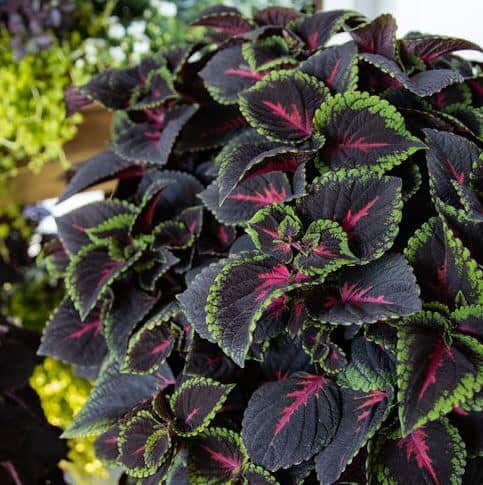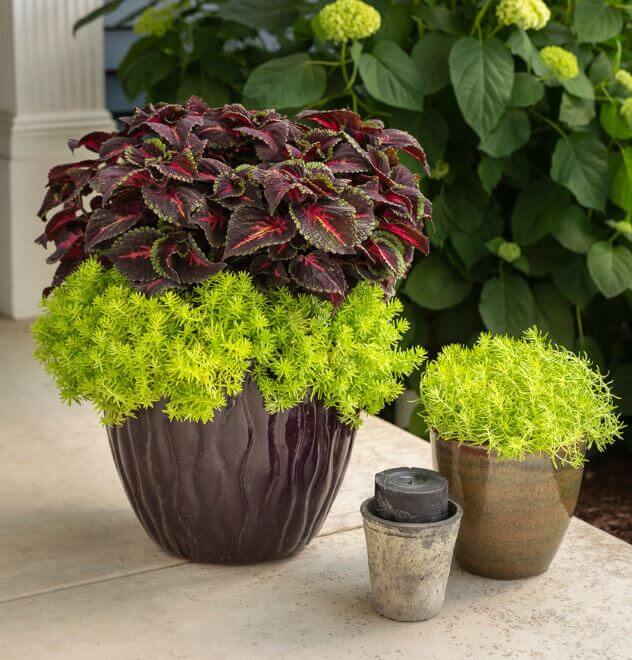Last Updated on April 24, 2023 by a Friendly Gardener
A showstopper in any garden, indoors or outside, the Colorblaze Torchlight Coleus is stunning wherever it is cultivated. This gorgeous giant boasts varying shades of lime green, cranberry red, and deep maroon and has won numerous awards. With a potential height of 40 inches and a width of thirty inches, this plant is the star regardless of whether it is container cultivated or the focal point of your garden bed.
The Coleus group of plants are herbaceous perennials that are generally cultivated as annuals and belong to the Lamiaceae or mint family. They can be found in tropical and subtropical Asia all the way to northern Australia. The name of the genus, Scutellaria, originates from the Latin term scutella meaning a small bowl that refers to the plant’s calyx. Apart from garden or container plants, it works well as a border plant, or as a hanging plant.
A Solenostemon Scutellarioides hybrid, this plant is a fuss-free ornamental cultivated for its striking foliage and can be adapted into a glorious houseplant. Deep burgundy leaves sport bright pink veins with chartreuse serrated borders.
Colorblaze Torchlight Coleus Plant Care

This lovely cultivar is very easy to maintain and grows rapidly to its full size. It is a wonderful choice for both indoor décor and outdoor gardens.
Soil
Your Coleus will do best in rich, moist, loose soil that is well-draining. Consider amending your garden or container soil with compost and adding in some perlite for drainage. Soil pH should measure from 6 to 7 or slightly acidic to neutral.
Light

The Colorblaze Torchlight Coleus can be cultivated in full sun, partial shade, or full shade. If you live in an environment with low humidity, opt for partial to full shade. For plants cultivated in full sun, select a spot that has at least six hours of sun exposure. Partial shade should have four to six hours of bright light and full shade spots should have between one to four hours of light available.
Do be careful when selecting a spot, especially if you prefer full sun. Depending on the sun’s strength, foliage can be subject to scorching in hot climates. Coleus does well with morning sun and afternoon shade in warmer climates.
Houseplants will need bright indirect sunlight and plenty of it. In winter a bit of direct sun exposition will go a long way. If plants become leggy, they need more light.
Water
The Coleus is not drought tolerant although it only requires average watering. The soil bed needs to maintain moisture without becoming soggy as this plant is susceptible to root rot. If you leave your plant without sufficient moisture, leaf edges will turn brown and crispy. Do allow the soil bed to dry out about an inch deep before watering. For outdoor plants, use mulch to aid in moisture retention. Never use cedar mulch as it is toxic to coleus plants and do not permit the mulch to come into contact with plant stems.
Outdoor container Coleus will require two waterings daily in the summer. Indoor houseplants will only need water when the soil bed feels dry to about an inch deep.
Humidity
As tropical plants, the Coleus likes high humidity. If your air is dry, consider moving your plant to a bathroom or use a space humidifier or a pebble tray.
Temperature
This Coleus cultivar is heat tolerant. It can be cultivated in USDA hardiness zones 10 and 11. This plant likes hot, humid environments. If you are cultivating outdoors, should temps fall to the 50s, move your plant indoors or provide protection. If you cannot, take cuttings before frost or chilly weather kills your plants. To move plants outdoors, wait until average temperatures are in the 70s.
Indoor houseplants should be kept away from air conditioning vents or chilly locations.
Feeding

Controlled-release plant food applied to the garden bed is ideal for this Coleus. It is not a heavy feeder, so one application should be adequate unless you have a particularly long season. In this case, a second application can be used for outdoor garden beds.
For container plants, it’s necessary to fertilize more often to encourage beautiful foliage. Use a liquid fertilizer once monthly during the spring, summer, and fall.
Pruning
If your Coleus is looking a little tired or worse for the wear, general trimming can do wonders. Prune approximately one-third of the plant. Fertilize after you have pruned to provide a boost of energy. To maintain foliage as the focal point of your plant, pinch off flowers and buds so the plant dedicates its energy to the foliage.
Expect that your Coleus will need a little time to recover from pruning, but the results will be worth the wait. Always remove damaged or dying leaves and trim throughout the season as necessary.
Potting and Repotting a Colorblaze Torchlight Coleus

When potting or repotting, use a larger pot so your plant has room to grow because these are rapid growers. You will need to repot as soon as the plant grows too much for its container. Watch for roots peeking out of drainage holes and the soil surface.
Colorblaze Torchlight Coleus Propagation

To propagate coleus, use stem cuttings.
- Cut a stem section beneath a leaf node that is 4 to 6 inches in length. Take off all the leaves from the bottom half of your stem cutting.
- Dip a cut end in rooting hormone and insert it in a container with moist soil. The soil should cover the leaf nodes.
- Cover the pot with plastic, but do not allow the plastic to touch the cutting.
- Place the stem cutting in a warm spot with bright indirect light for approximately three weeks until new roots develop.
- Remove the plastic and leave it in a warm and bright spot.
Coleus Colorblaze Torchlight Plant Problems
When cultivating your ColeusColorblaze Torchlight indoors beware of aphids, mealybugs, spider mites, and whiteflies.
For outdoor plants, know that both rabbits and groundhogs are fans of coleus so your plant will need protection from local wildlife.
This plant is not particularly susceptible to disease unless left in standing water. With soggy soil, fungal infections can develop like root rot or mildew.
Colorblaze Torchlight Coleus Toxicity
Coleus plants are considered toxic to cats, dogs, and horses.

